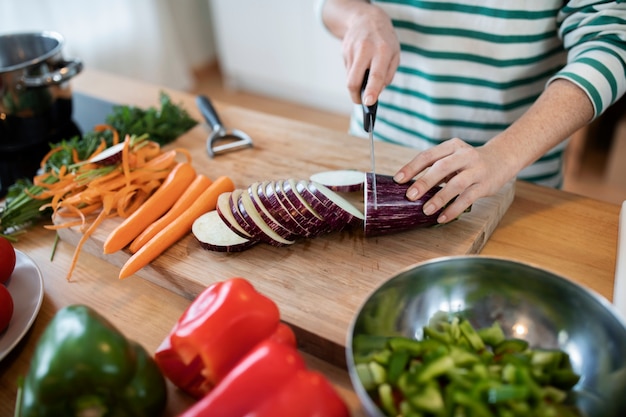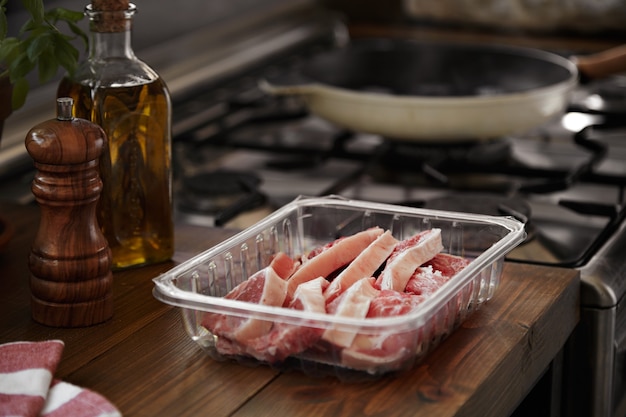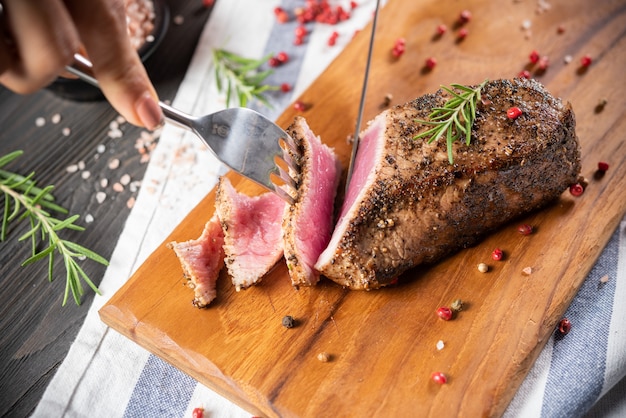You’ve got a beautiful pork loin in your fridge, ready to become the star of your next meal. You’ve seen those pictures of juicy, perfectly cooked pork, and you’re picturing it already: a golden-brown crust, tender meat that practically melts in your mouth. But then the doubt creeps in… how do you actually achieve that? The answer, my friend, lies in the temperature. It’s not just about throwing it in the oven and hoping for the best. Getting the internal temperature of your pork loin spot on is the key to unlocking its full potential. And guess what? I’m here to guide you through the whole process, sharing my personal experiences, tips, and tricks along the way. So grab your trusty meat thermometer, and let’s embark on this culinary adventure together!
(Part 1) The Science Behind the perfect pork loin

Why Temperature Matters: Understanding the "Why"
Cooking isn’t just about heat; it’s about understanding how that heat affects the food. When you cook pork, the heat causes the proteins to tighten up, which is what gives your pork loin that characteristic firmness. But cook it too long, and those proteins become tough and dry, leaving you with a disappointing dinner. That’s why we need to pay close attention to the temperature, and the best way to do that is with a trusty meat thermometer. It’s our little secret weapon for knowing exactly when our pork loin is ready.
The Danger Zone: A Temperature Range to Avoid
You’ve probably heard of the “danger zone,” that temperature range between 40°F and 140°F (4°C and 60°C) where bacteria can multiply like crazy. Imagine a microscopic party in your pork loin! That’s why it’s crucial to keep your pork loin out of this zone. Once it’s out of the fridge, it’s time to cook it as quickly as possible. Don’t let those bacteria have a chance to throw a bash!
The safe internal temperature: Ensuring food safety
The USDA recommends cooking pork loin to an internal temperature of 145°F (63°C). At this temperature, those pesky bacteria get the boot, ensuring your meal is safe to eat. But hold on! Safe doesn’t always mean delicious. We want our pork loin to be not only safe but also juicy, tender, and bursting with flavor.
(Part 2) The Quest for Juicy, tender pork loin: Achieving Flavorful Perfection

The Importance of Resting: Patience is a Virtue
Now, imagine this: you’ve cooked your pork loin to the perfect temperature, and you’re ready to carve it up. But wait! Don’t be hasty. Allow it to rest for about 10-15 minutes before slicing. This might seem like a small detail, but it’s a game-changer. Resting gives the juices a chance to redistribute throughout the meat, creating a juicy, tender, and flavorful result. It’s a bit like letting the pork loin catch its breath after its culinary adventure.
Beyond the Thermometer: Using Your Senses
While a meat thermometer is our trusty ally, it’s not the only tool in our culinary arsenal. We can also use our senses to guide us! A perfectly cooked pork loin has a beautiful, golden-brown crust. If you gently touch it, it should feel firm but not rock-hard. And lastly, give it a good sniff. A cooked pork loin should have a pleasant, savory aroma. Cooking is a combination of science and art. Using our senses helps us to understand what’s happening with our food, so we can create something truly delicious.
(Part 3) pork loin cooking methods: A culinary journey

There are so many ways to cook a pork loin! From oven roasting, which is a classic, to pan-frying for a quick weeknight dinner, to grilling for those perfect summer evenings, we have a method for every occasion and every taste. Let’s explore the possibilities!
Oven Roasting: The Classic Approach
Preparing for Perfection: Seasoning and Searing
Oven roasting is the tried-and-true method for creating a moist, tender, and flavorful pork loin. Here’s my approach: First, preheat your oven to 350°F (175°C). Then, it’s time to season our star ingredient. I always season my pork loin generously with salt and pepper. Don’t be shy with the seasoning! It’s like adding a layer of flavor to your masterpiece. You can also add other spices like paprika, garlic powder, and onion powder for a little extra oomph. I often use a combination of these to create a beautiful blend of flavors. You can even experiment with herbs like rosemary, thyme, or sage, depending on your preference. Just make sure you pat the pork loin dry with paper towels before seasoning so the seasoning adheres properly and doesn't get lost in a pool of moisture.
Here's a little trick I learned from my grandmother: to create a truly delicious crust, I sear the pork loin in a skillet over medium heat for about 5 minutes on each side. This gives it a nice browning and helps to seal in those precious juices. It’s like giving your pork loin a golden kiss before it goes into the oven.
Creating the Perfect Crust: A Secret Weapon
Once it’s seared, I transfer it to a baking dish and roast it in the preheated oven for about 1 hour and 15 minutes, or until the internal temperature reaches 145°F (63°C). Don’t forget to use your trusty meat thermometer to make sure it’s cooked to perfection.
Pan-Frying: Quick and Flavorful
Achieving a perfect sear: A Quick and Delicious Option
Pan-frying is a great option when you need a delicious meal in a hurry. For pan-frying, I heat a heavy-bottomed skillet over medium-high heat. A good skillet is essential for even cooking, so if you haven't got one, it might be worth investing in one! Then, add a bit of oil. You can use olive oil, vegetable oil, or even butter, whatever you prefer. Make sure it’s nice and hot before adding the pork loin. I like to sear the pork loin for about 3-4 minutes on each side, until it’s beautifully browned. Remember, a good sear is the key to creating a delicious crust!
Finishing the Cook: Ensuring Tenderness
Once it’s seared, I reduce the heat to medium and continue cooking for another 5-7 minutes, or until the internal temperature reaches 145°F (63°C). Make sure to rotate the pork loin every couple of minutes to ensure even cooking. After it’s cooked, let it rest for about 5 minutes before slicing and serving. This quick and easy method is perfect for a weeknight meal, and it’s amazing served with your favourite side dishes.
Grilling: A Summertime Delight
Prepping for the Grill: Summertime Flavors
Grilling is a fantastic way to add a smoky flavor to your pork loin, perfect for those warm summer evenings. Preheat your grill to medium-high heat. It’s important to have a hot grill for that beautiful sear. And just like with other methods, I make sure to season the pork loin generously with salt and pepper. You can also add other seasonings or marinades. You can create a rub by combining spices like paprika, garlic powder, onion powder, brown sugar, and chili powder for an extra burst of flavor. Let your creativity flow!
Grilling to Perfection: Mastering the Technique
Once your grill is hot, place the pork loin directly on the grates. I like to grill it for about 10-12 minutes, turning it every couple of minutes to ensure even cooking. You want those beautiful grill marks, right? And, of course, keep an eye on the internal temperature. Once it reaches 145°F (63°C), your pork loin is ready! Remove it from the grill and let it rest for about 10 minutes before slicing and serving. The smoky flavor from the grill combined with the juicy tenderness of the pork loin is a summery delight.
(Part 4) Mastering the Art of Marinating: Adding Flavor and Moisture
Unlocking Flavour Potential: A Taste of the Extraordinary
Want to add another dimension of flavor to your pork loin? Let's talk marinades! Marinades are a great way to infuse your pork loin with flavor and keep it moist during cooking. You can create your own marinade using your favorite ingredients or try a store-bought marinade. I often make a simple marinade using olive oil, lemon juice, garlic, and herbs like rosemary or thyme. It's a simple yet flavorful combination.
Maximizing Marinade Effectiveness: A Time for Flavor
For best results, I like to marinate the pork loin for at least 2 hours, but you can leave it for longer, even overnight. Just make sure to store the marinated pork loin in the fridge. A longer marinade time generally equals more intense flavor. The marinade will slowly seep into the meat, creating a symphony of taste.
Adding a Touch of Sweetness: A Touch of Magic
If you want a slightly sweeter flavor, you can add a touch of honey or maple syrup to your marinade. And for a bit of heat, add a pinch of red pepper flakes. Experiment with different ingredients to find your own signature marinade. There are no rules, just deliciousness waiting to be discovered.
(Part 5) pork loin recipes: A Culinary Toolkit
Now that we've explored the basics, let’s get into some specific recipes. Here are a few of my favorite pork loin recipes, each offering a unique flavor profile and texture.
Classic Roasted Pork Loin with Herbs and Garlic: A Time-Honored Classic
This is a tried-and-true classic. You'll need a 3-4 pound pork loin, about 2 tablespoons of olive oil, 1 tablespoon of dried rosemary, 1 tablespoon of dried thyme, 2 cloves of garlic, minced, and salt and pepper to taste. Preheat your oven to 350°F (175°C). Season the pork loin with salt, pepper, rosemary, thyme, and garlic. Place the pork loin in a roasting pan and rub the olive oil all over it. Roast for about 1 hour and 15 minutes, or until the internal temperature reaches 145°F (63°C). Let it rest for 10 minutes before slicing and serving. Serve it with roasted vegetables or mashed potatoes for a complete meal.
Pan-Seared Pork Loin with Maple-Glaze: Sweet and Savory Perfection
This recipe combines the deliciousness of pan-searing with a sweet and tangy glaze. You'll need a 1-2 pound pork loin, 1 tablespoon of olive oil, 1/4 cup of maple syrup, 2 tablespoons of Dijon mustard, and salt and pepper to taste. Heat a heavy-bottomed skillet over medium-high heat. Season the pork loin with salt and pepper. Sear it in the hot skillet for about 3-4 minutes on each side. Combine the maple syrup and Dijon mustard in a small bowl. Pour the glaze over the pork loin and continue cooking for another 5-7 minutes, or until the internal temperature reaches 145°F (63°C). Serve it with your favorite sides, such as roasted asparagus or sweet potato fries.
grilled pork loin with Peach Salsa: A Summery Delight
This recipe is perfect for summer grilling. You'll need a 1-2 pound pork loin, 1/4 cup of olive oil, 1 tablespoon of chili powder, 1 teaspoon of cumin, 1 teaspoon of garlic powder, 1 teaspoon of onion powder, 1/2 teaspoon of salt, 1/4 teaspoon of black pepper, 2 ripe peaches, diced, 1/2 red onion, diced, 1/4 cup of chopped cilantro, 2 tablespoons of lime juice, and salt and pepper to taste. Preheat your grill to medium-high heat. In a small bowl, combine the olive oil, chili powder, cumin, garlic powder, onion powder, salt, and pepper. Rub this mixture all over the pork loin. Grill for about 10-12 minutes, turning every couple of minutes. In a separate bowl, combine the peaches, red onion, cilantro, and lime juice. Season with salt and pepper. Serve the grilled pork loin with the peach salsa and a side of grilled corn on the cob.
(Part 6) Pork Loin and Sides: A Perfect Pair
Complementary Flavors: Creating a Culinary Symphony
Choosing the right sides to accompany your pork loin can make all the difference. I always aim for a balance of flavors and textures. For example, if you’re serving a roasted pork loin, you might want to consider a side of roasted vegetables, mashed potatoes, or a simple green salad. The creamy mashed potatoes provide a contrast to the tender pork, while the roasted vegetables add a burst of color and flavor. If you’re serving a pan-fried pork loin, a side of sautéed greens or a light salad would be a perfect complement.
Seasonal Inspiration: A Taste of the Moment
When choosing sides, consider the season. In the summer, you might opt for grilled vegetables, corn on the cob, or a refreshing salad. In the winter, you might choose roasted root vegetables, mashed potatoes, or a hearty green bean casserole. The possibilities are endless!
(Part 7) Storage and Leftovers: Making the Most of Your Culinary Triumph
Storing Cooked Pork Loin: Keeping It Fresh
After all that effort, you’ll probably have some leftovers, right? That’s great, because they make for a delicious lunch or dinner the next day. To store cooked pork loin, let it cool completely at room temperature, then transfer it to an airtight container and refrigerate it. The pork loin should be kept in the refrigerator for no more than 3-4 days.
Reheating Leftovers: A Culinary Resurrection
When you’re ready to reheat your leftovers, you have a few options. You can reheat them in the oven at 350°F (175°C) for about 15 minutes, or you can reheat them in the microwave. If you’re using the microwave, make sure to cover the container with a lid or plastic wrap to prevent the meat from drying out.
Creative Leftover Ideas: Transforming Your Leftovers
Don’t forget, leftovers can be a great starting point for a new dish. You can use leftover pork loin to make sandwiches, salads, or even a hearty pasta dish. Get creative and let your culinary imagination run wild!
(Part 8) FAQs: The pork loin guide
Q: How do I know if my pork loin is done?
The best way to tell if your pork loin is done is to use a meat thermometer. The safe internal temperature for cooked pork loin is 145°F (63°C). You can also check the texture of the pork loin. It should feel firm to the touch, but not hard.
Q: What happens if I overcook my pork loin?
If you overcook your pork loin, it will become tough and dry. The proteins in the meat will tighten up and become less tender. This is why it’s essential to cook pork loin to the correct temperature and not overcook it.
Q: Can I freeze pork loin?
Yes, you can freeze pork loin. To freeze it, wrap it tightly in plastic wrap or aluminum foil. It can be frozen for up to 3-4 months. When you’re ready to use it, thaw it in the refrigerator for 24 hours. Once thawed, it can be cooked as usual.
Q: What are some tips for keeping my pork loin juicy?
Here are a few tips for keeping your pork loin juicy: Don’t overcook it! Cook it to the recommended temperature and no more. Let it rest for 10-15 minutes after cooking to allow the juices to redistribute. Use a marinade to infuse the pork loin with moisture. Use a meat thermometer to ensure that you’re cooking it to the correct temperature.
Q: What are some of the best side dishes for pork loin?
There are many delicious side dishes that pair well with pork loin. Here are a few ideas: Roasted vegetables, mashed potatoes, sweet potato fries, green salads, grilled corn on the cob, asparagus, and sautéed greens. Choose sides that complement the flavors and textures of your pork loin and your overall meal.
(Part 9) A Final Bite: Enjoying Your Culinary Triumph
There you have it! From understanding the science behind the perfect pork loin to exploring different cooking methods and recipes, you’re now equipped to cook a pork loin that will impress your family and friends. Remember, cooking is a journey, not a destination. So, don’t be afraid to experiment and discover new flavors. And most importantly, enjoy the process! After all, a delicious pork loin is best enjoyed with good company and a hearty appetite. Happy cooking!
Everyone is watching

Corn on the Cob: The Ultimate Guide to Perfectly Cooked Ears
Healthy MealsAh, corn on the cob. Just the name evokes images of sunny days, barbecues, and that sweet, juicy flavour that ...

Perfect Pork Roast Oven Cooking Time: A Guide to Delicious Results
Healthy MealsThere's something truly satisfying about a perfectly roasted pork. The aroma alone is enough to make your mout...

Scallops: The Ultimate Guide to Perfect Cooking
Healthy MealsAh, scallops. Those delicate, sweet, and utterly delicious morsels of the sea. They hold a special place in my...

Ham Cooking Time: How Long to Bake, Smoke, or Boil a Delicious Ham
Healthy MealsAh, ham. It's a classic, isn't it? A real crowd-pleaser, especially around holidays. And when done right, it'...

Spaghetti Squash: The Ultimate Guide to Cooking and Serving
Healthy MealsRemember that time you saw spaghetti squash at the supermarket, looking all bumpy and strange, and thought, "W...
